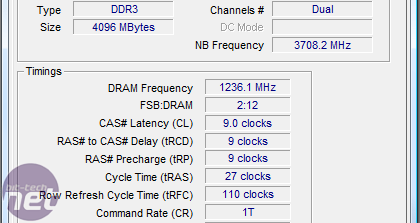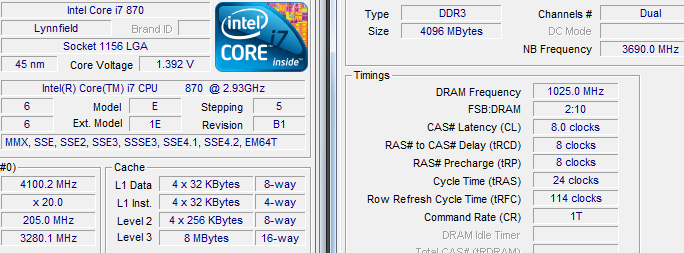Overclocking
We squeezed out a little more base clock than the micro-ATX P55M-UD4: 205MHz versus 202MHz before, yielding a slightly faster CPU NB frequency (3690MHz versus 3636MHz), QPI (3280MHz versus 3232MHz), and memory (1025MHz versus 1010MHz), but we had to drop back the multiplier by one (21x to 20x) leaving the overall CPU frequency 142MHz slower.This was at 1.42V CPU, 1.4V VTT(QPI), 1.86V PLL, 1.08V P55 PCH, 1.66V memory and the "standard" performance profile with Level 2 loadline calibration and spectrum spread disabled.
All we can say for sure is the Gigabyte boards can handle a good overclock, and the extra slight base clock over the 200-mark can help squeeze a little extra from a worthy CPU, providing the voltage and cooling.
It's unsurprising the UD4 and UD5 are similar given the top half of both are almost identical in terms of power hardware for the CPU and memory, their cooling, and general PCB layout.
Squeezing the most out of the base clock, we found the board could hit almost the same as the P55-UD4M at 210MHz stable at 1.4V VTT - any higher actually did nothing for it. However it's the memory performance that is exceptional. If you do want to splash out for super specially high performance DIMMs (like our G.Skill Perfect Storm 2,200MHz CL8 kit), we found the board could achieve 2,472MHz at 9-9-9-27-110-1T, 1.72V just about, but it was much happier at a nice round 2,400MHz at the same timings and 1.70V. To achieve this though you'll need an i7 Lynnfield with the 12x multiplier unlocked because i5s don't offer this.

Power Consumption
We have to give Gigabyte credit, the Dynamic Energy Saver software does get progressively better with every iteration. The latest from the Gigabyte website finally shows us what the difference between Level 1-3 are: basically more parts of the motherboard have their power supply controlled under the DES software, with Level 1 being only the CPU and memory, whereas Level 3 includes everything: CPU, memory, P55 chispet, hard drives, etc.
The results are still less than wonderful though. For a company that insists on hardware solutions for everything its use of Intersil software continues to cause issues and we found under idle the system used 2W more with the software running than with it off. We strongly have to highlight that 2W was an average over several minutes here, since the power use jumped around by several watt far more with it turned on.
Under load, we do see a very positive change of nearly 10W in favor of the DES software. This was under Level 3, with everything being controlled, but selecting Level 2 made the power use rise to about 188W and Level 1 effectively left it the same as if it had been turned off.
Comparatively though, even without the DES software, the Gigabyte board sets itself up well against the competition when idle, although when loaded it's several watts greedier than the MSI GD65 and Gigabyte P55M-UD4. Let's not forget the P55M-UD4 is a Micro-ATX board, with only half the PCB to power, and the UD5 has plenty of extra hardware to power offering a cumulative effect.

MSI MPG Velox 100R Chassis Review
October 14 2021 | 15:04










Want to comment? Please log in.